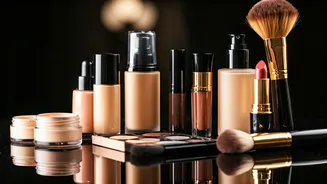Primer: The Foundation
Makeup primers function as the essential base for any successful makeup routine. They provide a smooth, even canvas for makeup application, helping to
minimize the appearance of pores, fine lines, and uneven skin texture. By creating this ideal surface, primers significantly improve the wear time of foundation, eyeshadow, and other cosmetics. They also help to prevent makeup from creasing or fading throughout the day. Choosing the right primer depends heavily on individual skin type and the specific concerns to be addressed. For instance, individuals with oily skin might opt for mattifying primers that control shine, whereas those with dry skin might favor hydrating primers that provide moisture. Furthermore, primers can offer additional benefits such as color correction, which helps to even out skin tone and reduce redness or discoloration. Incorporating a primer into your makeup routine is a small step with a big impact, leading to a more professional and long-lasting finish.
Fixers: The Sealant
Setting sprays, or makeup fixers, are the final touch in achieving long-lasting makeup. These sprays are designed to lock in the makeup, preventing it from smudging, fading, or transferring onto clothes or other surfaces. Fixers work by forming a protective layer over the applied makeup, which helps to maintain its integrity throughout the day. The formulations of setting sprays vary widely, with options available to cater to different skin types and desired finishes. Some setting sprays provide a matte finish, ideal for those with oily skin, by absorbing excess oil and reducing shine. Others offer a dewy finish, perfect for those with dry skin, adding a natural glow to the complexion. Furthermore, many setting sprays contain ingredients that help to hydrate the skin, enhancing the overall comfort and wearability of the makeup. Applying a setting spray is typically the last step in your makeup routine, usually sprayed from a distance of about six to eight inches, ensuring an even distribution over the face. This simple step can make a considerable difference in the longevity and appearance of your makeup.
Choosing the Right Products
Selecting the right primer and setting spray is crucial for achieving optimal results. Consider your skin type as the primary factor; oily skin benefits from mattifying products, while dry skin requires hydrating formulas. Review product ingredients to ensure they are suitable for your skin's needs, avoiding potential irritants or allergens. Research product reviews and recommendations to gauge performance and user satisfaction. Reading about other users' experiences with different products can offer valuable insights and help you make informed decisions. Consider the finish you desire—matte, dewy, or natural—and choose products that will help achieve that look. Test products when possible, either at a store or by requesting samples, to ensure they blend well with your skin tone and makeup style. Furthermore, the environment you live in can influence your product choice. Those in humid climates might require long-wearing, water-resistant formulas, whereas those in drier climates might prefer hydrating options. Careful consideration of these factors will help you find the perfect primer and setting spray for your individual needs.
Application Techniques
The application methods for primers and setting sprays significantly affect their effectiveness. Apply primer after your skincare routine and before applying foundation or any other makeup. Use clean fingertips or a makeup sponge to distribute the primer evenly across the face, focusing on areas with larger pores or uneven texture. Allow the primer a few minutes to set before applying makeup. For setting spray, hold the bottle about six to eight inches away from your face and spray evenly, ensuring full coverage. Avoid spraying too much product, which can lead to a heavy, artificial finish. For extended wear, consider applying a second layer of setting spray after you have completed your makeup. Another technique involves using a makeup sponge to press the setting spray into the skin, which can help to further blend the makeup and extend its staying power. Furthermore, consider the application tools; using a clean brush or sponge ensures an even distribution of the product, maximizing its benefits. Practicing these techniques will help to achieve a flawless, long-lasting makeup look.
Common Mistakes
Avoiding common application errors is key to maximizing the benefits of primers and setting sprays. A frequent mistake is applying too much product, which can lead to a cakey or heavy appearance. Start with a small amount and build up as needed. Another error is neglecting to let the primer or setting spray set, as this can affect the longevity of your makeup. Always allow the product to dry before applying subsequent layers or venturing out. Using the wrong product for your skin type is another common pitfall. For instance, using an oil-based primer on oily skin can exacerbate shine. Regularly cleaning your makeup brushes and sponges is vital to prevent bacteria and ensure smooth application. Failing to prep the skin properly before applying primer and makeup can also lead to poor results. Always cleanse, moisturize, and apply sunscreen before starting your makeup routine to create the best base. By avoiding these common mistakes, you can significantly enhance the effectiveness of your makeup products.












